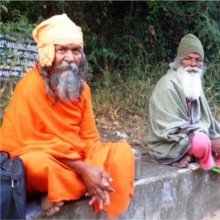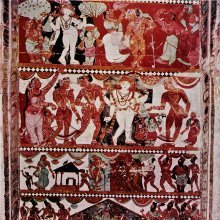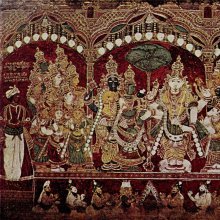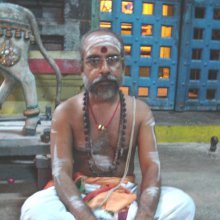Chidambaram: 2 definitions
Introduction:
Chidambaram means something in the history of ancient India. If you want to know the exact meaning, history, etymology or English translation of this term then check out the descriptions on this page. Add your comment or reference to a book if you want to contribute to this summary article.
Images (photo gallery)
India history and geography
Source: archive.org: Chaitanya’s life and teachings (history)Chidambaram is a town and municipality in Cuddalore district in the Indian state of Tamil Nadu. It is the headquarters of the Chidambaram taluk. The town is believed to be of significant antiquity and has been ruled, at different times, by the Pallavas until 9th century, Medieval Cholas, Later Cholas, Later Pandyas, Vijayanagar Empire, Marathas and the British. The town is known for the Thillai Nataraja Temple, and the annual chariot festival held in the months of December–January (In the Tamil month of Marghazhi known as "Margazhi Urchavam") and June to July (In the Tamil month of Aani known as "Aani Thirumanjanam").
The traditional name of the temple complex, Chidambaram Tillai Nataraja-koothan Kovil. As per Hindu legend, god Shiva was strolling in Thillai Vanam. In the Thillai forests resided a group of sages who believed in the supremacy of magic and that god can be controlled by rituals and mantras. Shiva wanted to test the sages and strolled in the forest with assuming the form of Bhikshatana, a simple mendicant seeking alms. He was followed by his consort, Vishnu as Mohini. The sages and their wives were enchanted by the beauty of the pair. On seeing their womenfolk enchanted, the sages got enraged and invoked scores of serpents (nagas) by performing rituals.
Source: Shodhganga: Temple management in the Āgamas (history)Chidambaram (छिदम्बरम्) is the name of a village hosting one of the oldest Hindu temple.—Some of the oldest temples of India can be found in the south. The temple of Lord Naṭarāja in Chidambaram is said to be originally built by the Chola chieftain Siṃhavarman (550-575 CE) after he was cured of a skin ailment after bathing in the tank in the middle of a Thillai forest. Successive kings and dynasties have enhanced the structure, including Āditya I (871-907 CE) who first thatched the roof with gold.
Source: Shodhganga: Siddha Cult in TamilnaduChidambaram refers to one of the various famous Siddha Centre distributed throughout South India and Tamil Nadu. The Siddha cult represents a Tantric philosophy that emerged from the combination of several elements found in traditions such as Shaivism (viz., Pashupata), Shaktism, Jainism, Tantric Buddhism (Vajrayana), etc. Both the Siddha and the Navanath cult (i.e., Nava-natha, ‘nine saints’) are popular in South India [viz., Chidambaram] and Tamilnadu. A Siddha was an inspired seer belonging to the marginalized sections of society who dissolved their past karma and crushed the roots of future karma.

The history of India traces the identification of countries, villages, towns and other regions of India, as well as mythology, zoology, royal dynasties, rulers, tribes, local festivities and traditions and regional languages. Ancient India enjoyed religious freedom and encourages the path of Dharma, a concept common to Buddhism, Hinduism, and Jainism.
See also (Relevant definitions)
Ends with: Melaiccitamparam.
Full-text (+63): Cittirakutam, Cidambara, Tillainayakan, Porcapai, Ampalavan, Gundra, Citampararakaciyam, Tiruvampalam, Manravanan, Tirucciṟṟampalam-kōyil, Civakami, Capapati, Nagalinga, Puliyur, Nanacapai, Pandya, Koyirpuranam, Perampalam, Tillai-tiru-cittirakutam, Circapai.
Relevant text
Search found 19 books and stories containing Chidambaram; (plurals include: Chidambarams). You can also click to the full overview containing English textual excerpts. Below are direct links for the most relevant articles:
Later Chola Temples (by S. R. Balasubrahmanyam)
Temples in Chidambaram < [Chapter II - Temples of Kulottunga I’s Time]
Temples in Chidambaram (Parakesarinallur) < [Chapter IV - Temples of Vikrama Chola’s Time]
Temples in Alangudi < [Chapter IV - Temples of Vikrama Chola’s Time]
The Recovery of the Devaram Hymns < [June 1943]
The Political Scene < [April – June and July – September, 1996]
A Medieval Saint < [January 1937]
Early Chola Temples (by S. R. Balasubrahmanyam)
Seven-storeyed Gopuram: Chidambaram < [Chapter XIII - Prasada: Component Parts]
Bronze, group 2: Age of Aditya I (a.d. 871-907) < [Chapter XI - Sculpture]
Kashyapa Shilpa-shastra (study) (by K. Vidyuta)
1. Conclusion (Prākāras) < [Chapter 6 - Conclusion]
3. Conclusion (Gopuras) < [Chapter 6 - Conclusion]
2. Conclusion (Maṇḍapas) < [Chapter 6 - Conclusion]
Middle Chola Temples (by S. R. Balasubrahmanyam)
Appointment of Temple Servants and Administrative Arrangements < [Tanjavur/Thanjavur (Rajarajesvaram temple)]
Amman Shrine < [Tanjavur/Thanjavur (Rajarajesvaram temple)]
Vastu-shastra (5): Temple Architecture (by D. N. Shukla)
Temples of Madura, the final phase (from 1600 A.D.) < [Chapter 12 - History of Hindu Temples (Prāsādas and Vimānas)]
Pāṇḍya Prākāras and Gopuras < [Chapter 12 - History of Hindu Temples (Prāsādas and Vimānas)]




